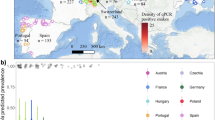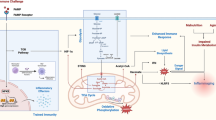Abstract
Parasites play a prominent role in the ecology, evolution, and more recently, conservation of many organisms. For example, emerging infectious diseases, including a group of lethal ranaviruses, are associated with the declines and extinctions of amphibians around the world. An increasingly important basic and applied question is: what controls parasite virulence? We used a dose-response experiment with three laboratory-bred clutches of tiger salamander larvae (Ambystoma tigrinum) to test how the size of inoculum and host genetic factors influence the dynamics and outcome of ranavirus infections. We found that infection rates increased with dose and were strongly affected by clutch identity and host life history stage. Case mortality increased with dose of inoculum, but was unaffected by host characteristics. Average survival time decreased with dose and differed among clutches, but this was largely due to differences in the time to onset of symptoms. Overall, our results suggest that dose of inoculum and host characteristics (life history stage and genetic background) influence the establishment and early virus replication, and therefore the virulence of ranavirus infections.



Similar content being viewed by others
References
Arthurs S, Thomas MB (2001) Effect of dose, pre-mortem host incubation temperature and thermal behaviour on host mortality, mycosis and sporulation of Metarhizium anisopliae var. acridum in Schistocerca gregaria. Biocontrol Sci Technol 11:411–420
van Beek NAM, Wood HA, Hughes PR (1988) Quantitative aspects of nuclear polyhedrosis virus infections in lepidopterous larvae: the dose–survival time relationship. J Invertebr Pathol 51:58–63
van Beek N, Hughes PR, Wood HA (2000) Effects of incubation temperature on the dose–survival time relationship of Trichoplusia ni larvae infected with Autographa californica nucleopolyhedrovirus. J Invertebr Pathol 76:185–190
Bollinger TK, Mao J, Schock D, Brigham RM, Chinchar VG (1999) Pathology, isolation, and preliminary molecular characterization of a novel iridovirus from tiger salamanders in Saskatchewan. J Wildl Dis 35:413–429
Brunner JL, Schock DM, Collins JP, Davidson EW (2004) The role of an intraspecific reservoir in the persistence of a lethal ranavirus. Ecology 85:560–566
Carey C, Cohen N, Rollins-Smith L (1999) Amphibian declines: an immunological perspective. Dev Comp Immunol 23:459–472
Chotivanich K, Udomsangpetch R, Simpson JA, Newton P, Pukrittayakamee S, Looareesuwan S, White NJ (2000) Parasite multiplication potential and the severity of falciparum malaria. J Infect Dis 181:1206–1209
Cleaveland S, Laurenson MK, Taylor LH (2001) Diseases of humans and their domestic mammals: pathogen characteristics, host range and the risk of emergence. Philos Trans R Soc Lond Ser B Biol Sci 356:991–999
Cohen N (1969) Immunogenetic and developmental aspects of tissue transplantation immunity in Urodele amphibians. In: Mizell M (ed) Biology of amphibian tumors. Springer, Berlin Heidelberg New York, pp 153–168
Collins JP, Jones TR, Berna HJ (1988) Conserving genetically-distinctive populations: the case of the Huachuca tiger salamander (Ambystoma tigrinum stebbinsi Lowe). In: Szaro RC, Severson KC, Patton DR (eds) Management of amphibians, reptiles, and small mammals in North America, vol GTR-RM-166. USDA Forest Service, Rocky Mountain Forest and Range Experiment Station, Fort Collins, pp 45–53
Collins JP, Brunner JL, Miera V, Parris MJ, Schock DM, Storfer S (2003) Ecology and evolution of infectious disease. In: Semlitsch R (ed) Amphibian conservation. Smithsonian Institution Press, Washington, pp 137–151
Collins JP, Brunner JL, Jancovich J, Schock DM (2004) A model host-pathogen system for studying infectious disease dynamics in amphibians: tiger salamanders (Ambystoma tigrinum) and Ambystoma tigrinum virus. Herpetol J 14:195–200
Daszak P, Cunningham AA, Hyatt AD (2001) Anthropogenic environmental change and the emergence of infectious diseases in wildlife. Acta Trop 78:103–116
Daszak P, Cunningham AA, Hyatt AD (2003) Infectious disease and amphibian population declines. Divers Distrib 9:141–150
Day T (2002a) The evolution of virulence in vector-borne and directly transmitted parasites. Theor Popul Biol 62:199–213
Day T (2002b) On the evolution of virulence and the relationship between various measures of mortality. Proc R Soc Lond Ser B Biol Sci 269:1317–1323
Day T (2002c) Virulence evolution via host exploitation and toxin production in spore-producing pathogens. Ecol Lett 5:471–476
Diffley P, Scott JO, Mama K, Tsen TNR (1987) The rate of proliferation among African trypanosomes is a stable trait that is directly related to virulence. Am J Trop Med Hyg 36:533–540
Dobson A, Foufopoulos J (2001) Emerging infectious pathogens of wildlife. Philos Trans R Soc Lond Ser B Biol Sci 356:1001–1012
Dybdahl MF, Storfer A (2003) Parasite local adaptation: Red Queen versus Suicide King. Trends Ecol Evol 18:523–530
Ebert D (1999) The evolution and expression of parasite virulence. In: Stearns SC (ed) Evolution in health and disease. Oxford University Press, New York, pp 161–172
Ebert D, Zschokke-Rohringer CD, Carius HJ (2000) Dose effects and density-dependent regulation of two microparasites of Daphnia magna. Oecologia 122:200–209
Elliott SL, Blanford S, Thomas MB (2002) Host–pathogen interactions in a varying environment: temperature, behavioural fever and fitness. Proc R Soc Lond Ser B Biol Sci 269:1599–1607
Ewald PW (1991) Waterborne transmission and the evolution of virulence among gastrointestinal bacteria. Epidemiol Infect 106:83–119
Friend M, McLean RG, Dein FJ (2001) Disease emergence in birds: challenges for the twenty-first century. Auk 118:290–303
Galvani AP (2003) Epidemiology meets evolutionary ecology. Trends Ecol Evol 18:132–139
Gibbons JW, Scott DE, Ryan TJ, Buhlmann KA, Tuberville TD, Metts BS, Greene JL, Mills T, Leiden Y, Poppy S, Winne CT (2000) The global decline of reptiles, Deja Vu amphibians. Bioscience 50:653–666
Green DE, Converse KA, Schrader AK (2002) Epizootiology of sixty-four amphibian morbidity and mortality events in the USA, 1996–2001. Ann N Y Acad Sci 969:323–339
Hochberg ME (1991) Intra-host interactions between a braconid endoparasitoid, Apanteles glomeratus, and a baculovirus for larvae of Pieris brassicae. J Anim Ecol 60:51–63
Jancovich JK, Davidson EW, Morado JF, Jacobs BL, Collins JP (1997) Isolation of a lethal virus from the endangered tiger salamander Ambystoma tigrinum stebbinsi. Dis Aquat Organ 31:161–167
Jancovich JK, Davidson EW, Seiler A, Jacobs BL, Collins JP (2001) Transmission of the Ambystoma tigrinum virus to alternate hosts. Dis Aquat Organ 46:159–163
Koella JC, Agnew P (1999) A correlated response of a parasite’s virulence and life cycle to selection on its host’s life history. J Evol Biol 12:70–79
Mackinnon MJ, Read AF (1999) Selection for high and low virulence in the malaria parasite Plasmodium chabaudi. Proc R Soc Lond Ser B Biol Sci 266:741–748
Mao J, Tham TN, Gentry GA, Aubertin A, Chinchar VG (1996) Cloning, sequence analysis, and expression of the major capsid protein of the iridovirus frog virus 3. Virology 216:431–436
Morand S, Poulin R (2000) Optimal time to patency in parasitic nematodes: host mortality matters. Ecol Lett 3:186–190
Prybylski D, Khaliq A, Fox E, Sarwari AR, Strickland GT (1999) Parasite density and malaria morbidity in the Pakistani Punjab. Am J Trop Med Hyg 61:791–801
Rollins-Smith LA (1998) Metamorphosis and the amphibian immune system. Immunol Rev 166:221–230
Sabelis MW, Metz JAJ (2002) Taking stock: relating theory to experiment. In: Dieckmann U, Metz JAJ, Sabelis MW, Sigmund K (eds) Adaptive dynamics of infectious diseases: in pursuit of virulence management. Cambridge University Press, New York, pp 379–398
Straley SC, Perry RD (1995) Environmental modulation of gene-expression and pathogenesis in Yersinia. Trends Microbiol 3:310–317
Timms R, Colegrave N, Chan BHK, Read AF (2001) The effect of parasite dose on disease severity in the rodent malaria Plasmodium chabaudi. Parasitology 123:1–11
Acknowledgements
This work was supported in part by NSF IRCEB (Integrated Research Challenges in Environmental Biology) grant #DEB 0213851 to JPC and 22 collaborators, and by an NSF Doctoral Dissertation Improvement grant #DEB 0309099 to JLB. Animal experiments were approved under ASU animal care protocols 99-526R and 03-670R and comply with the current laws of the United States of America. Thanks also to Thomas Dowling and Ann Kelsen for help with PCR, and to V. Gregory Chinchar, Nicholas Cohen, Elizabeth Davidson, Stanley Faeth, Amy Greer, Angela Picco, Richard Retallick, and two anonymous reviewers for helpful comments and suggestions that significantly improved this manuscript.
Author information
Authors and Affiliations
Corresponding author
Additional information
Communicated by Carla Caceres
Rights and permissions
About this article
Cite this article
Brunner, J.L., Richards, K. & Collins, J.P. Dose and host characteristics influence virulence of ranavirus infections. Oecologia 144, 399–406 (2005). https://doi.org/10.1007/s00442-005-0093-5
Received:
Accepted:
Published:
Issue Date:
DOI: https://doi.org/10.1007/s00442-005-0093-5




